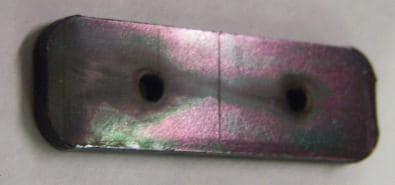
Home of the world famous 'finishing.com HOTLINE' since 1989
-----
New to Black Chromate Conversion on Acid Chloride Zinc
We own a plating shop and we run an Acid Chloride Zinc plating bath. At the request of our customers we are trying our hand at Black Chromate. We already do clear and yellow fine, but are running into problems with the black. We are using a proprietary solution, made up with distilled water. No agitation. After Zinc plating, we go through two rinses, non-distilled water.Then rinse with fresh water, non-distilled, before chromating. We do not have a water distiller. The parts look o.k. but are not uniform. Some have what looks like a dull streaky film on them. Some look sort of iridescent. Some are fine. We tried a trivalent black a few weeks ago but for some reason it looked horrible. What might we be doing wrong?

plating shop employee - Springdale, Arkansas
April 7, 2009
April 15, 2009
Hex black (silver containing) on chloride zinc requires that you have very good rinsing before chromating. You must not drag any chloride into the chromate. The chloride reacts with the silver containing component of the chromate bath.
I would suggest that you mildly acidify the first rinse with 1-2% by volume Sulfuric Acid to remove any brightener film from the parts. If you do not already, agitate the rises and chromate (not with air for the chromate, you do not want airborne hexavalent chromium!). Analyze the hex chrome bath when you get the iridescence, I would suspect that you are then low in the silver bearing component.
Trivalent chromates will work. The representative from the manufacturer or distributor should work with you to overcome the problems. But please note: in my opinion the finish is different than hex black.
process supplier - Great Neck, New York
Everything Mr Packman said is the first and most popular solution to the symptoms you show. The current silver bearing chromate might be already too full of chloride. After you correct the chloride problem, then consider:
The least black in your picture shows up in the lower current density areas of the part. So peroxide treat your chloride zinc to remove iron. The black chromate with/without chloride, will not take over zinc-iron alloy which you apparently have in the low current density areas.

Robert H Probert
Robert H Probert Technical Services
Garner, North Carolina

April 16, 2009
Thanks for the responses. We have started rinse each rack of black parts with fresh water and it has helped a lot. Now, what would we agitate the black chromate with if not air? We are currently not using any agitation in it. And, secondly, please explain the peroxide treatment a little further. Thanks!
Leslie Patrickmetal finishing shop - Springdale, Ar, U.S.A.
April 22, 2009
No dead threads!
Your Q, A, or Comment puts this thread on The Finishing.com HOTLINE.